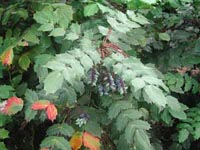Resource Library
Plant of the Week: Mahonia, Leatherleaf
The University of Arkansas System Division of Agriculture does not promote, support or recommend plants featured in "Plant of the Week." Please consult your local Extension office for plants suitable for your region.
Plant of the Week
Leatherleaf Mahonia
Latin: Mahonia bealei

To an extent, plants follow the same guise as art. Most popular art and popular plants are non-threatening - they are what they are and don't force the viewer into accepting scary ideas from outside their zone of comfort.
Leatherleaf Mahonia, though, is an abstraction of a plant - as if some spaced out artist had combined the tentacles of an octopus with the sharp pointed spines of a desert shrub. The result is a shrub gardeners either love or hate, just as they love or hate abstract art.
Leatherleaf Mahonia (Mahonia bealei) is native to China and a close relative of the barberry. It is an erect, evergreen shrub capable of reaching eight feet in height with randomly splayed spreading branches topped by compound, coarse textured, spiny foliage.
The gray-green leaves contain nine to thirteen leaflets and are a foot or more long. Each leaflet is armed with five or more needle-sharp spines.
In February an equally bizarre bright yellow inflorescence appears in the central whorl of leaves at the ends of the branches. The inflorescence consists of a series of six inch spikes radiating around the central axis of the plant, each of which has a series of small, fragrant yellow cups extending down its length. In early summer gray-blue, peanut-sized berries are produced.
Leatherleaf Mahonia was introduced to the West by Robert Fortune (1812-1880), a plant collector sent by the East Indies Company to infiltrate the tea growing regions of China. Fortune made this trip, the second of three, in 1848 and six years after the Opium Wars opened thirteen port cities as trading centers with the rest of the world.
The Opium Wars are clear evidence that wars fought to keep the wheels of business turning are destructive to all concerned. By winning the war and forcing open the trading ports, England got to trade opium for tea while Americans became the principle provider of that other noxious weed, tobacco.
The treaty signed after the War gave Westerners access to an area 30 miles distant from each city, but Fortune wanted to go inland about 200 miles. To accomplish this he shaved his head, donned a Chinese robe, booked passage on a boat and headed inland. His disguise was a poor one and the boat crew bragged at every stop about having a Westerner on board, but he reached the tea-growing region unscathed and acquire the requested information and plants.
Because his first trip in 1842 had been under the sponsorship of the Royal Horticultural Society, he was keen to find new and interesting ornamentals. One day he spied a tree growing inside a walled garden, but the only way in was through the house.
Not shy or long on social graces in a foreign land, he and his two Chinese assistants brazenly walked in the front door, through the house and into the back garden. There he first met with the new Mahonia. He considered digging it up but decided it was too large to survive the move.
At the next stop he showed leaves to a group of locals and offered a reward to anyone who could acquire the new plant for him. Three plants soon came his way. They were left in the care of Thomas Beale, a merchant in Shanghai who provided Fortune a base of operation while in China and was honored as the namesake for the species.
Leatherleaf Mahonia became a hit in England and was soon offered by American nurserymen. It is best used in the shade garden as a specimen plant where it's outlandish habit of growth can be exploited. Instead pruning it to look like a clipped holly hedge, prune away some of the foliage and allow the eccentric nature of this interesting plant to be exposed. Once established it is very drought tolerant and free from serious insect or disease problems.
By: Gerald Klingaman, retired
Extension Horticulturist - Ornamentals
Extension News - January 20, 2004
The University of Arkansas System Division of Agriculture does not maintain lists of retail outlets where these plants can be purchased. Please check your local nursery or other retail outlets to ask about the availability of these plants for your growing area.